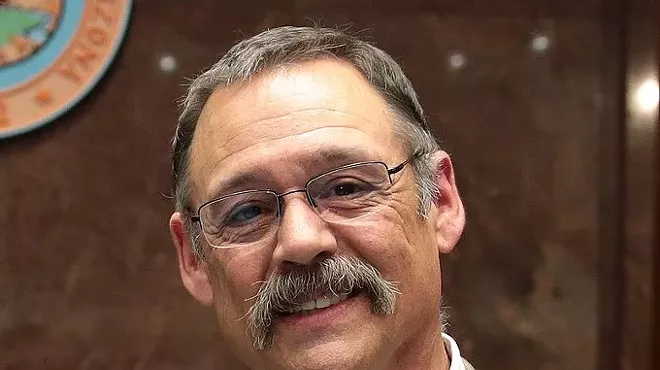Thursday, February 25, 2016
New Report Suggests Medical Negligence By ICE Leads to Deaths in Immigration Detention Centers
Mexico native Pablo Gracida-Conte died at the age of 54 of heart disease while incarcerated at the Eloy Detention Center five years ago. His condition was treatable, but it took four months for Immigration and Customs Enforcement staff to get him medical treatment, even though he had repeatedly requested it upon entering the detention center.
During his 142-day stay in detention, he complained of ongoing health issues. He'd vomit nearly after every meal and suffered extreme upper abdominal pain.
Gracida-Conte had a difficult time communicating with Eloy staff because he mostly spoke Mixteco—an indigenous language from the Mexican states of Oaxaca, Puebla and Guerrero. Although there were telephone interpreters available to facilitate the community, staff never accessed one.
His repeated cries for help were ignored.
In October 2011, Gracida-Conte became the 10th person since 2003 to die while apprehended at the Corrections Corporation of American-run Eloy Detention Center.
But there's a pattern here.
A report published today by the American Civil Liberties Union, the Detention Watch Network and the National Immigrant Justice Center finds that systematic medical negligence by ICE has contributed to several deaths in detention centers around the country. The findings aren't conclusions drawn by advocates, rather they are a summary of information gathered through death review documents by ICE itself—which were later obtained by these organizations through a Freedom of Information Act request.
In the case of at least eight death reviews, "ICE investigators found that detention centers are non-compliant to ICE standards," said Mary Small, policy director at the Detention Watch Network, in a press conference call this morning. (She then referred to the Eloy Detention Center as one of the deadliest in the country. There have been at least five suicides there.)
Carl Takei, staff attorney with the ACLU, added that in said reviews ICE even attributed some of these medical standard failures to the causes of death. The wrongdoings the agency pointed out include failure to meet health care needs in a timely manner, failure to refer individuals to higher medical care providers like hospitals, failure to provide adequate medical staff, and failure to screen individuals of illnesses. What's worse, ICE did not care to identify these mistakes and rectify them, Takei says.
"These findings indicate the grievous violations of ICE medical care standards," he says. What's more disturbing to Takei is that, usually, these death reviews are there to improve the care of the next person who may need medical attention. Instead of using these reviews to reduce future deaths, ICE put them under the rug, Takei says.
He describes another death—this one in a detention center in Aurora, Colorado. Evalin-Ali Mandza, an immigrant from Gabon, died in April 2012 of a heart attack "after egregious delays in calling 911 and referring Mr. Mandza to a higher level provider," the report says.
On that April morning, a guard called a code blue emergency because he saw Mandza holding his chest and complaining of severe pain. He was having a heart attack. A nurse at the facility, who was not trained to deal with the situation, misdiagnosed Mandza. A doctor did authorize the use of an ambulance to transfer Mandza, 46, to a hospital, but the call to 911 was not made until an hour later. He died at the hospital a couple of hours after.
ICE's death review found that each of the medical protocol violations in Mandza's case "may have been contributing factors to Mr. Mandza's death...[He] did not have access to appropriate medical care while detained."
"Despite these damming findings, ICE's routine annual inspections before and after Mr. Mandza's death ....gave the [detention center] passing ratings," Takei says. In fact, the inspectors seemed to have excused Mandza's death, writing that he received "timely and comprehensive medical and mental health screening" and reporting "no significant past medical history," denying any significant risk factors of heart disease leading up to his death. "They did not mention anything about the serious violations identified in Mr. Mandza's death review," Takei says. "Instead of ignoring its investigations, ICE must learn from its deadly errors."
Dora Schriro, former Department of Homeland Security adviser to ex-secretary Janet Napolitano, said she issued a report on concerns back in 2009. Among the problems, the health care system at facilities were poorly equipped, lacked infrastructure, and the medical personnel wasn't trained well. And, there was basically "no medical or mental health classification system. At the time, they just characterized incoming detainees as either 'healthy' or 'unhealthy,'" she says. There was no maintenance of medical records when a person was transferred to another facility, as well as grave transparency issues when a person died under the custody of ICE.
Ultimately, the agency should:
Release people with serious medical and mental health needs, particularly when individuals require higher-level care.Read the entire report.
Immediately terminate contracts for facilities with repeated preventable deaths, such as the Eloy Detention Center.
Shift current funding for detention to community-based alternatives, which will allow people to seek medical attention and receive support from family, legal counsel, and community.
And apply current ICE detention standards to all facilities used by ICE and discontinue contracts where current standards are not being met.
Revise Performance-Based National Detention Standards to require that medical care providers be held responsible for meeting the health care needs of individuals in ICE custody as opposed to simply providing “access” to health care.
Improve the inspections process by ensuring that inspections are more effectively used to hold facilities accountable.
Create an independent medical advisory committee to investigate deaths that occur in detention.
Tucson Weekly put in a request with ICE for comment. We will update the article once we get it.
Tags: american civil liberties union , detention watch network , national immigrant justice center , immigration and customs enforcement , eloy detention center , immigration , arizona













